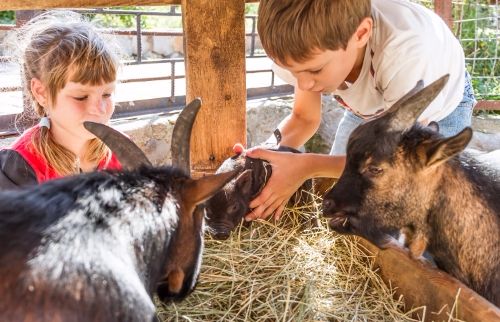Animal Venues
Program Contacts
Stacey Koltas MPH, REHS
Program Manager
216.201.2000 ext 1253
skoltas@ccbh.net
The Cuyahoga County Board of Health Animal Venue Program protects the public from the health and safety risks that are associated with animals in public settings.
Animals can provide valuable and unique opportunities for education and entertainment. However, numerous illness outbreaks, exposure incidents and injuries have been associated with fairs, petting zoos, pet stores and other animal exhibits.
Factors associated with disease transmission and injury typically include inadequate hand washing, exposure to sick or dangerous animals, contact with contaminated environments, and lack of public awareness. Through the implementation of the Animal Venue Program, the Board of Health strives to promote and ensure good public health practice at animal venues.
The Animal Venue Program is conducted under the authority of the Cuyahoga County Board of Health Animal Venue Regulation. All animal venues that operate within the CCBH jurisdiction are required to obtain an annual Animal Venue Permit to Operate.
An animal venue includes any operation that sells, distributes or exhibits animals to the public. The Animal Venue Permit is valid from May 1 to April 30 of each year. CCBH conducts a minimum of one inspection per year to ensure compliance with the Animal Venue Regulation.
The application for an animal venue permit must be submitted in April of each year. An application for a temporary animal venue permit must be submitted at least one week prior to participating in an event.
Click here to view the Animal Venue Permit Application
Click here to view the Mobile Animal Venue Permit Application
Click here to view the Temporary Animal Venue Permit Application
Diseases Associated with Animal Venues
Bacteria, viruses and other microorganisms that cause disease are known as pathogens. Diseases that are transmissible from animal to man are known as zoonotic diseases. Of the 1,415 known pathogens that cause disease in humans, 61% are zoonotic.
Of the 175 pathogens defined as emerging diseases, 75% are zoonotic and the majority of bioterrorism agents are zoonotic diseases.
Animals can harbor a number of different pathogens. Some may cause visible illness in animals, while others do not. Factors such as confinement, transportation, crowding, and increased handling by people can increase the likelihood that animals will shed these pathogens.
Whether animals appear sick or not, the surfaces of their bodies, their waste products, saliva and other bodily fluids can all be contaminated with these microorganisms that cause disease.
Disease transmission occurs when people handle ill animals, touch contaminated surfaces, eat contaminated food or water, are exposed to animal waste, are bitten or scratched by an animal, or are bitten by an insect that is carrying the disease.
When people are exposed to animals in public settings, the potential for disease transmission is present. To protect the public, the Animal Venue Program serves to ensure that measures to prevent disease and injury are practiced at venues such as fairs, farms, pet stores, shelters, traveling shows, and educational exhibits.
Livestock, reptiles and other domestic animals are often sources of enteric diseases. Wild and exotic animals can be sources of emerging and re-emerging diseases.
Disease Surveillance
CCBH conducts disease surveillance to identify any unusual incidence of disease in our communities. Reports are received daily and quarterly reports are compiled throughout the year. All cases of disease receive appropriate public health follow-up in an effort to prevent severe illness and outbreaks in humans.
Because many of our reportable diseases are zoonotic, animal venue operators are required to report illness and disease in animals, as well as human injuries and exposure incidents associated with animals. CCBH works closely with the Ohio Department of Health to investigate outbreaks and clusters of disease associated with animal exposures.
Confirmed or suspected cases of zoonotic disease or any unusual illness observed in animals can be reported to CCBH by completing our Veterinary Reporting Form and emailing the form to skoltas@ccbh.net or faxing it to 216.676.1316.
As required in state and local codes, animal bite or exposure incidents must be reported to Cuyahoga County Board of Health within 24 hours. Fax a completed Animal Bite Report form to 216.676.1317 or contact us by phone at 216.201.2000.
Veterinary Disease Reporting Program
CCBH continues to maintain a close working relationship with our local veterinary industry. A voluntary zoonotic disease reporting program was initiated in 2011 which will assist our office in identifying trends in local disease activity associated with our local pet population. To assist in this effort, veterinarians are asked to submit a Veterinary Reporting Form to the CCBH office when they diagnose a reportable zoonotic disease.
Federal, State and Local Requirements
At the federal, state and local levels, animal venues may have additional requirements. The U.S. Department of Agriculture governs venues that sell exotic animals or that exhibit animals under the Animal Welfare Act. The Centers for Disease Control & Prevention, the U.S. Fish & Wildlife Service, and the U.S. Department of Agriculture all have roles in regulating the international and interstate movement of animals.
The Ohio Department of Natural Resources – Division of Wildlife regulates the possession and propagation of wild native species. Private or commercial ownership of four or more wild animals that are indigenous to Ohio requires a permit to ensure conservation of wild native species.
The Ohio Department of Agriculture regulates the livestock and poultry industries for purposes of food safety, and animal health and welfare. Ohio Revised Code requires that diseases classified as Dangerously Contagious and Infectious, as well as any unusual morbidity and mortality of unknown cause, be reported to the Ohio Department of Agriculture.
The Ohio Department of Agriculture also governs dangerous wild animals.
At the local level, the majority of municipalities within Cuyahoga County have ordinances that regulate animals. Please contact your respective community for more information.





